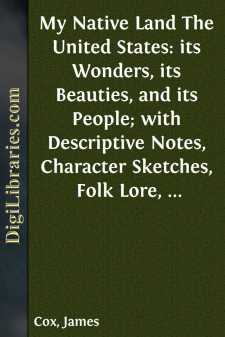Categories
- Antiques & Collectibles 13
- Architecture 36
- Art 48
- Bibles 22
- Biography & Autobiography 813
- Body, Mind & Spirit 142
- Business & Economics 28
- Children's Books 15
- Children's Fiction 12
- Computers 4
- Cooking 94
- Crafts & Hobbies 4
- Drama 346
- Education 46
- Family & Relationships 57
- Fiction 11828
- Games 19
- Gardening 17
- Health & Fitness 34
- History 1377
- House & Home 1
- Humor 147
- Juvenile Fiction 1873
- Juvenile Nonfiction 202
- Language Arts & Disciplines 88
- Law 16
- Literary Collections 686
- Literary Criticism 179
- Mathematics 13
- Medical 41
- Music 40
- Nature 179
- Non-Classifiable 1768
- Performing Arts 7
- Periodicals 1453
- Philosophy 64
- Photography 2
- Poetry 896
- Political Science 203
- Psychology 42
- Reference 154
- Religion 513
- Science 126
- Self-Help 84
- Social Science 81
- Sports & Recreation 34
- Study Aids 3
- Technology & Engineering 59
- Transportation 23
- Travel 463
- True Crime 29
My Native Land The United States: its Wonders, its Beauties, and its People; with Descriptive Notes, Character Sketches, Folk Lore, Traditions, Legends and History, for the Amusement of the Old and the Instruction of the Young
by: James Cox
Description:
Excerpt
CHAPTER I.
OUR NATION'S BIRTH.
The Story of Liberty Bell--Impartial Opinions on the Revolutionary War--The Shot that was Heard Around the World--The First Committee of Safety--A Defeat which Equaled a Victory--Washington's Earnestness--To Congress on Horseback--The First 4th of July Celebration.
It was not until April 19th, 1775, that the shot was fired which was "heard around the world." But the struggle for American Independence was really started nearly a quarter of a century earlier, when on the afternoon of August 27th, 1753, Liberty Bell was rung to call together the Assembly of the Province of Pennsylvania.
In the old days of town meetings, training days, town schools and Puritans, bells took a more prominent part in public affairs than they do to-day. It was usual to call the people together for purposes of deliberation by means of a village or town bell, and of these bells the one to which we refer was the most important and interesting. Liberty Bell is well named. It was ordered in the year 1751, and it was delivered a year later. Shortly afterwards, it cracked, and had to be recast, but in June, 1753, it was finally hung in the Pennsylvania State House at Philadelphia. It has never been removed from the building except on two occasions. The first of these was in 1777, when it was taken to Allentown for safety, and the second in 1885, when it was exhibited at New Orleans.
This bell, which sounded the death-blow to tyranny and oppression, was first rung to call together the Assembly, which immediately resolved to insist upon certain rights which had been denied the colonists by the British Crown. Eighteen months later, it was again rung to announce the meeting at which the rights of the colonists were sternly defined and insisted upon. In 1765, it convened the meeting of the Assembly at which it was resolved to be represented at the Congress of the Colonies in New York, and a month later it was muffled and tolled when the "Royal Charlotte" arrived, bearing the much hated stamps, whose landing was not permitted. Again it rang muffled, when the Stamp Act went into operation, and when the people publicly burned stamp papers. In 1768, the Liberty Bell called a meeting of the men of Philadelphia, who protested once again against the oppression of government without representation. In 1771, it called the Assembly together to petition the King of England for the repeal of the duty on tea, and two years later it summoned together the largest crowd ever seen in Philadelphia up to that date. At that meeting it was resolved that the ship "Polly," loaded with tea, should not be allowed to land.
In 1774, the bell was muffled and tolled on the closing of the Port of Boston, and in the following year it convened the memorable meeting following the battle of Lexington. On this occasion 8,000 people assembled in the State House yard and unanimously agreed to associate for the purpose of defending, with arms, their lives, liberty and property against all attempts to deprive them of them....


